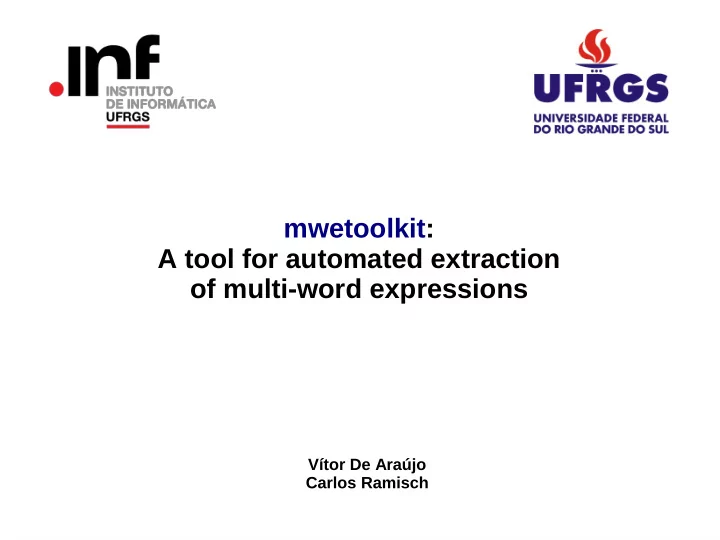

mwetoolkit: A tool for automated extraction of multi-word expressions Vítor De Araújo Carlos Ramisch
Multi-word expressions Combinations of words that present linguistical or statistical idiosyncrasies ● Phrasal verbs: carry up, consist of ● Support verbs: take a walk, make a decision ● Compounds: computer science, washing machine ● Idiomatic expressions: raining cats and dogs, on the other hand mwetoolkit ( mwetoolkit.sf.net ) : ● Automated tool for MWE extraction from corpora ● Linguistical methods (morphosyntactic patterns) ● Statistical methods (association measures)
MWEs in natural language processing MWEs are ubiquitous in natural language Everyday expressions Technical terminology MWEs are hard to deal with Non-compositional: give up Conventional/arbitrary: computer science Domain-specific: binary tree, angiosperm tree A challenge to any NLP system requiring semantic processing E.g., machine translation: give up → *dar para cima
How does it work? Patterns Association Filtered Candidate 3 4 1 measures candidates list Corpus 5 2 Web Index Output
How does it work? Patterns Association Filtered Candidate 3 4 1 measures candidates list Corpus 5 2 Web Index Output <pat> <ngram> <w pos=”A”/> <w surface="human" pos="A"/> <w pos=”A”/> <w surface="cd4+" pos="A"/> <w pos=”N”/> <w surface="t" pos="N"/> <w pos=”N”/> <w surface="cells" pos="N"/> </pat> <freq name="corpus" value="2"/> </ngram>
How does it work? Patterns Association Filtered Candidate 3 4 1 measures candidates list Corpus 5 2 Web Index Output
How does it work? Patterns Association Filtered Candidate 3 4 1 measures candidates list Corpus 5 2 Web Index Output
How does it work? Patterns Association Filtered Candidate 3 4 1 measures candidates list Corpus 5 2 Web Index Output <cand candid="2247"> <ngram> <w surface="human" pos="A"><freq name="corpus" value="78" /></w> <w surface="cd4+" pos="A"><freq name="corpus" value="5" /></w> <w surface="t" pos="N"><freq name="corpus" value="75" /></w> <w surface="cells" pos="N"><freq name="corpus" value="152" /></w> <freq name="corpus" value="2" /></ngram> <occurs> ... <features> <feat name="mle_corpus" value="0.000156201187129" /> <feat name="pmi_corpus" value="19.8491824326" /> <feat name="t_corpus" value="1.41421206505" /> <feat name="dice_corpus" value="0.0258064516129" /> <feat name="ll_corpus" value="0.0" /> </features> </cand>
How does it work? Patterns Association Filtered Candidate 3 4 1 measures candidates list Corpus 5 2 Web Index Output
Patterns Literal pattern <pat> <w pos=”A”/> <w pos=”N”/> <w pos=”N”/> </pat> E.g., modern computer science <pat> <w lemma="take" pos="V" /> <w pos=”Det”/> <w pos=”N”/> </pat> E.g., take a walk
Patterns Regular expressions Repetitions, optional items <pat> <pat repeat=”?” ><w pos=”Det”/></pat> <pat repeat=”*” ><w pos=”A”/></pat> <pat repeat=”+” ><w pos=”N”/></pat> </pat> Backreferences <pat> <w pos=”N” id=”n1”/> <w pos=”Prep”/> <w pos=”N” lemma=”back:n1.lemma” /> </pat> E.g., day after day, step by step, hand in hand
Patterns Non-contiguous MWEs <pat> <w pos=”VT”/> <pat repeat=”*” ignore=”true” ><w/></pat> <w pos=”Adv”/> </pat> E.g. throw whatever away Syntactic dependencies E.g., verb and its object <pat> <w pos=”VT” id=”v1”/> <pat repeat=”*” ignore=”true”><w/></pat> <w pos=”N” syndep=”dobj:v1” /> </pat>
Index Suffix array Per-attribute Automatic attribute fusion E.g., lemma+pos (verb "like" vs. noun "like") On-the-fly index generation from lemma and pos C indexing routines British National Corpus 110 million words ~5min per attribute (lemma, surface, pos) ~1GB memory
Other improvements Unified command-based interface Use of Web 1 Trillion 5-gram as a source of frequencies LocalMaxs algorithm: extraction without filtering Preliminar evaluation: MWE extraction in the discourse of children for study on language acquisition (CHILDES)
Conclusions Demo paper V. de Araújo, C. Ramisch, A. Villavicencio. Fast and Flexible MWE Candidate Generation with the mwetoolkit. In Proceedings of the Workshop on Multiword Expressions: from Parsing and Generation to the Real World (MWE 2011), pages 134–136, Portland, Oregon, USA, 23 June 2011. http://aclweb.org/anthology-new/W/W11/W11-0822.pdf Improvement, optimization and evaluation of a MWE extraction tool: a challenge for NLP Difficulties in MWE identification → Flexible patterns, syntactic information → New identification algorithms Consumption of computing resources → More efficient algorithms and routines
Future work Compare mwetoolkit with other tools Handling of nested MWEs E.g., [inverse [kappa B [transcription factor]]] Improve the performance of candidate extraction
Recommend
More recommend